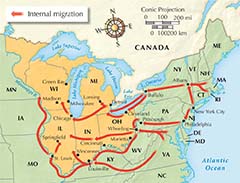Document-Based Assessment
Settling the Northwest Territory
From 1787 on, huge numbers of American settlers poured into the Northwest Territory, frequently coming into conflict with the people who already lived there. How did the newcomers and the Native Americans interact? Use your knowledge of American western expansion and Documents A, B, C, and D to answer questions 1 through 4.
Document A
“The utmost good faith shall always be observed towards the Indians; their lands and property shall never be taken from them without their consent; and, in their property, rights, and liberty, they shall never be invaded or disturbed, unless in just and lawful wars authorized by Congress; but laws founded in justice and humanity, shall from time to time be made for preventing wrongs being done to them, and for preserving peace and friendship with them.”
—Northwest Ordinance of 1787, Section 14, Article 3
Document B
“At present, we do not think of ourselves perfectly secure from [the Indians] on account of a few lawless bandits made up of Mingos, Shawnees, and Cherokees, who reside at present on the waters of the Scioto [River]. These are a set of thievish, murdering rascals…. [L]et the treaty end how it may…. [The] little skulking parties of Indians, if they are never won over to be our friends, can never do us any considerable injury. On the other hand, should there be a general Indian war, this will be a place of general rendezvous for an army. So that, in all human probability, the settlement can never fail of the protection of government.”
—Rufus Putnam, Superintendent, Ohio Land Company, 1788
Document C
“A white man gathers from a field, a few times bigger than his room, bread enough for a whole year. If he adds to this a small field of grass, he maintains beasts … while we must have a great deal of ground to live upon. A deer will serve us a couple of days, and a single deer must have a great deal of ground to put him in good condition. If we kill two or three hundred a year, ’tis the same as to eat all the wood and grass of the land they live on and that is a great deal. No wonder the whites drive us every year further before them from the sea to the Mississippi. They spread like oil on a blanket; we melt like snow before the sun.”
—Little Turtle, Miami Chief, 1792
Document D

Movement into the Northwest Territory
- Document A could best be described as a
- treaty.
- charter.
- constitution.
- law.
- What can you conclude from Document B?
- Native Americans were all lawless.
- Rufus Putnam opposed “a general Indian war.”
- Soldiers were marching to Ohio.
- Settlers living along the Scioto River felt that Native Americans there were not a major threat.
- According to Document C, Little Turtle thought American expansion
- was due to missionary activity.
- was fueled by racism.
- could likely be halted.
- was inevitable because of differences in land use.
- Writing Task Did Americans in the Northwest Territory adhere to the provisions of the Northwest Ordinance of 1787 regarding native peoples? Use your knowledge of American history and evidence from the sources above to explain your answer.




